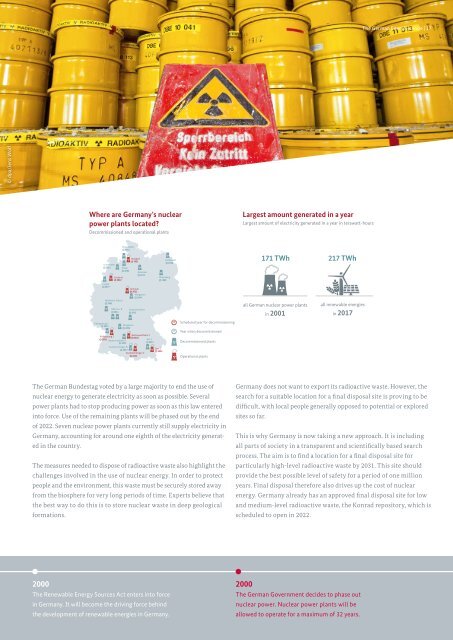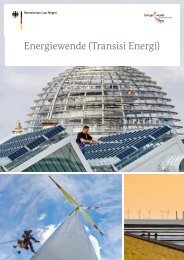The German Energiewende
Create successful ePaper yourself
Turn your PDF publications into a flip-book with our unique Google optimized e-Paper software.
<strong>The</strong> <strong>German</strong> <strong>Energiewende</strong> | 17<br />
© dpa/Jens Wolf<br />
Where are <strong>German</strong>y’s nuclear<br />
power plants located?<br />
Decommissioned and operational plants<br />
Largest amount generated in a year<br />
Largest amount of electricity generated in a year in terawatt-hours<br />
Brunsbüttel<br />
2011<br />
Brokdorf<br />
2021<br />
Unterweser<br />
2011<br />
Stade<br />
2003<br />
Krümmel<br />
2011<br />
Emsland<br />
2022<br />
Greifswald<br />
1990<br />
Rheinsberg<br />
1990<br />
171 TWh<br />
217 TWh<br />
Lingen<br />
1977<br />
Mühlheim-Kärlich<br />
2001<br />
Biblis A + B<br />
2011<br />
Grohnde<br />
2021<br />
Würgassen<br />
1994<br />
Grafenrheinfeld<br />
2015<br />
all <strong>German</strong> nuclear power plants<br />
in 2001<br />
all renewable energies<br />
in 2017<br />
Philippsburg 1<br />
2011<br />
Obrigheim<br />
2005<br />
Neckarwestheim 2<br />
Philippsburg 2<br />
2022<br />
2019<br />
Isar 1<br />
Neckarwestheim 1<br />
2011<br />
2011<br />
Scheduled year for decommissioning<br />
Year when decommissioned<br />
Decommissioned plants<br />
Gundremmingen B<br />
2017<br />
Gundremmingen C<br />
2021<br />
Isar 2<br />
2022<br />
Operational plants<br />
<strong>The</strong> <strong>German</strong> Bundestag voted by a large majority to end the use of<br />
nuclear energy to generate electricity as soon as possible. Several<br />
power plants had to stop producing power as soon as this law entered<br />
into force. Use of the remaining plants will be phased out by the end<br />
of 2022. Seven nuclear power plants currently still supply electricity in<br />
<strong>German</strong>y, accounting for around one eighth of the electricity generated<br />
in the country.<br />
<strong>The</strong> measures needed to dispose of radioactive waste also highlight the<br />
challenges involved in the use of nuclear energy. In order to protect<br />
people and the environment, this waste must be securely stored away<br />
from the biosphere for very long periods of time. Experts believe that<br />
the best way to do this is to store nuclear waste in deep geological<br />
formations.<br />
<strong>German</strong>y does not want to export its radioactive waste. However, the<br />
search for a suitable location for a final disposal site is proving to be<br />
difficult, with local people generally opposed to potential or explored<br />
sites so far.<br />
This is why <strong>German</strong>y is now taking a new approach. It is including<br />
all parts of society in a transparent and scientifically based search<br />
process. <strong>The</strong> aim is to find a location for a final disposal site for<br />
particularly high-level radioactive waste by 2031. This site should<br />
provide the best possible level of safety for a period of one million<br />
years. Final disposal therefore also drives up the cost of nuclear<br />
energy. <strong>German</strong>y already has an approved final disposal site for low<br />
and medium-level radioactive waste, the Konrad repository, which is<br />
scheduled to open in 2022.<br />
2000<br />
<strong>The</strong> Renewable Energy Sources Act enters into force<br />
in <strong>German</strong>y. It will become the driving force behind<br />
the development of renewable energies in <strong>German</strong>y.<br />
2000<br />
<strong>The</strong> <strong>German</strong> Government decides to phase out<br />
nuclear power. Nuclear power plants will be<br />
allowed to operate for a maximum of 32 years.

















